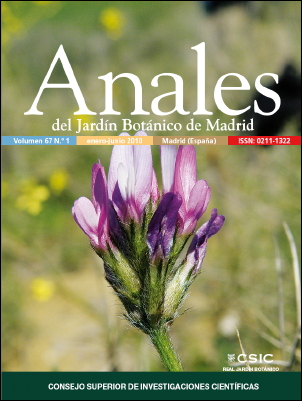Cardosoa, un nuevo género de la subtribu Anisopappinae (Athroismeae, Asteraceae).
DOI:
https://doi.org/10.3989/ajbm.2235Palabras clave:
Asteridae, Compositae, África tropical, Angola, Huambo, sistemática, taxonomía, morfologíaResumen
Se describe el nuevo género Cardosoa de la subtribu Anisopappinae (Athroismeae, Asteraceae) para la especie Anisopappus athanasioides del planalto de Angola. Se discuten los caracteres morfológicos más distintivos del nuevo género, especialmente frente a Anisopappus. Los caracteres morfológicos de mayor valor diagnóstico son el tipo de inflorescencia y la presencia en Cardosoa de flores marginales bilabiadas y flores del disco zigomorfas en mayor o menor medida.
Descargas
Citas
Anderberg, A.A. 1991. Taxonomy and phylogeny of the tribe Inuleae (Asteraceae). Plant Systematics and Evolution 176: 75-123. doi:10.1007/BF00937947
Anderberg, A.A. 1994. Tribe Inuleae. In: Bremer K. (ed.), Asteraceae. Cladistics & Clasification: 273-291. Portland, Oregon, Timber Press.
Anderberg, A.A. 2009. Athroismeae. In: Funk., V.A., Susanna, A., Stuessy, T.F. & Bayer, R.J. (eds.), Systematics Evolution and Biogeography of the Compositae: 681-688. IAPT, Vienna.
Anderberg, A.A. & Eldenäs, P. 2007. Tribe Inuleae. In: Kadereit, J. W. & Jeffrey, C. (eds.), The Families and Genera of Vascular Plants, vol. 8, Flowering Plants. Eudicots. Asterales: 374-391. Berlin, Springer.
Anderson, L.E. 1954. Hoyer’s solution as a rapid mounting medium for bryophytes. Bryologist 57: 242-247.
Brouillet, L., Lowrey, T.K., Urbatsch, L., Karaman-Castro, V., Sancho, G., Wagstaff, S. & Semple, J.C. 2009. Astereae. In: Funk., V.A., Susanna, A., Stuessy, T.F. & Bayer, R.J. (eds.), Systematics Evolution and Biogeography of the Compositae: 589-629. IAPT, Vienna.
Eldenäs, P. & Anderberg, A.A. 1996. A cladistic analysis of Anisopappus (Asteraceae: Inuleae). Plant Systematics and Evolution 199: 167-192. doi:10.1007/BF00984903
Eldenäs, P., Anderberg, A.A. & Källersjö, M. 1998. Molecular phylogenetics of the tribe Inuleae s. str. (Asteraceae), based on ITS sequences of nuclear ribosomal DNA. Plant Systematics and Evoution 210: 159-173. doi:10.1007/BF00985666
Eldenäs, P., Källersjö, M. & Anderberg, A.A. 1999. Phylogenetic placement and circumscription of tribes Inuleae s. str. and Plucheeae (Asteraceae): evidence from sequences of chloroplast gene ndhF. Molecular Phylogenetics and Evolution 13: 50-58. doi:10.1006/mpev.1999.0635 PMid:10508538
Kim, H.-G. & Jansen, R.K. 1995. ndhF sequence evolution and the major clades in the sunflower family. Proceedings of the Natural Academy of Sciences of the United States of America 92: 10379-10383. doi:10.1073/pnas.92.22.10379
Ortiz, S. & Paiva, J.A.R. 1995. Notes on African species of the genus Anisopappus Hook. & Arn. (Asteraceae). Botanical Journal of the Linnaean Society 117: 39-46.
Ortiz, S., Paiva, J.A.R. & Rodríguez-Oubiña, J. 1996. An outline of the genus Anisopappus Hook. & Arn. (Compositae). Anales del Jardín Botánico de Madrid 54: 378-391.
Panero, J.L. 2005. New combinations and infrafamilial taxa in the Asteraceae. Phytologia 87(1): 1-14.
Panero, J.L. 2007. Tribe Athroismeae. In: Kadereit, J.W. & Jeffrey, C. (eds.), The Families and Genera of Vascular Plants. Flowering Plants. Eudicots. Asterales 8: 395-400. Berlin, Springer.
Panero, J.L. & Funk, V.A. 2002. Toward a phylogenetic subfamilial classification for the Compositae (Asteraceae). Proceedings of the Biological Society of Washington 115(4): 909-922.
Panero, J.L. & Funk, V.A. 2008. The value of sampling anomalous taxa in phylogenetic studies: Major clades of the Asteraceae revealed. Molecular Phylogenetics and Evolution 47: 757-782. doi:10.1016/j.ympev.2008.02.011 PMid:18375151
Descargas
Publicado
Cómo citar
Número
Sección
Licencia
Derechos de autor 2010 Consejo Superior de Investigaciones Científicas (CSIC)

Esta obra está bajo una licencia internacional Creative Commons Atribución 4.0.
© CSIC. Los originales publicados en las ediciones impresa y electrónica de esta Revista son propiedad del Consejo Superior de Investigaciones Científicas, siendo necesario citar la procedencia en cualquier reproducción parcial o total.
Salvo indicación contraria, todos los contenidos de la edición electrónica se distribuyen bajo una licencia de uso y distribución “Creative Commons Reconocimiento 4.0 Internacional ” (CC BY 4.0). Consulte la versión informativa y el texto legal de la licencia. Esta circunstancia ha de hacerse constar expresamente de esta forma cuando sea necesario.
No se autoriza el depósito en repositorios, páginas web personales o similares de cualquier otra versión distinta a la publicada por el editor.















